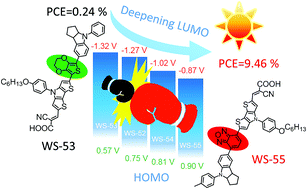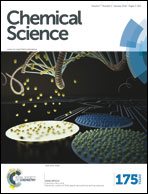Unprecedentedly targeted customization of molecular energy levels with auxiliary-groups in organic solar cell sensitizers†
Abstract
In dye-sensitized solar cells (DSSCs), the HOMO–LUMO energy gap of organic sensitizers should be large enough to enable efficient electron injection and dye regeneration. However, the LUMOs of most practical organic dyes are always too high, making energy “waste”. In order to deepen the LUMOs, we focus on the targeted modulation of the molecular energy levels by embedding an electron donor or acceptor into the skeleton of a typical D–π–A model. The electron-rich group of 3,4-ethylenedioxythiophene (EDOT) lifts up the HOMO level with little influence on the LUMO, while the electron-deficient group of benzothiadiazole (BTD) or benzooxadiazole (BOD) mainly lowers the customized LUMO level. As a consequence, the auxiliary group change from EDOT (dye WS-53) to BOD (dye WS-55) brings forth a huge photoelectric conversion efficiency (PCE) increase by 38 fold from 0.24 to 9.46% based on an I−/I3− redox couple, and even reaching a high PCE of 10.14% with WS-55 under 0.3 sunlight irradiation.

- This article is part of the themed collection: Global Energy Challenges: Solar Energy

 Please wait while we load your content...
Please wait while we load your content...